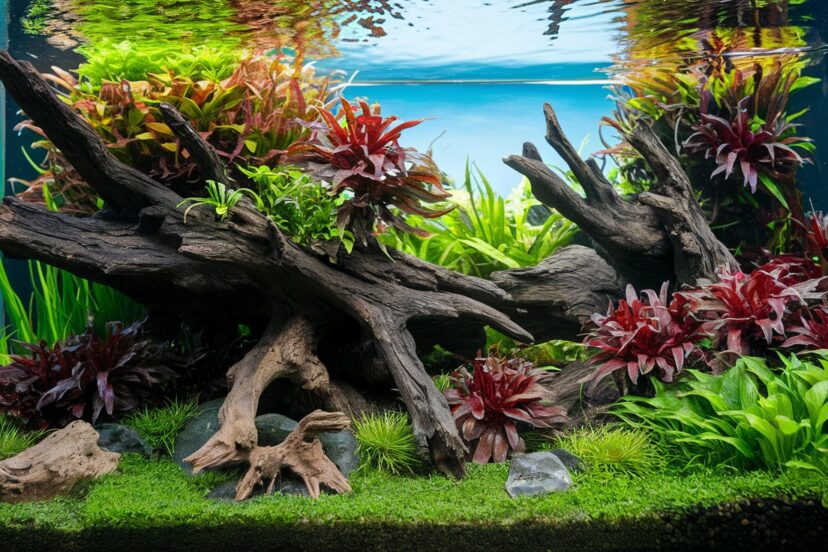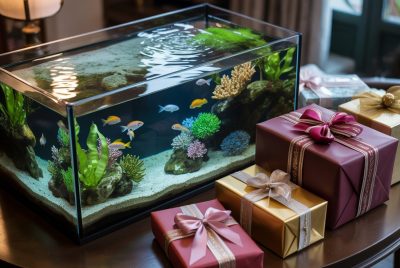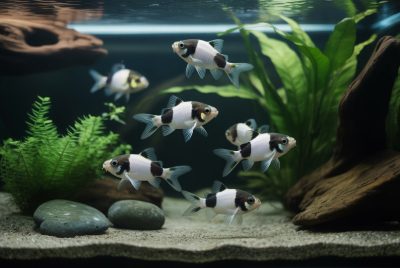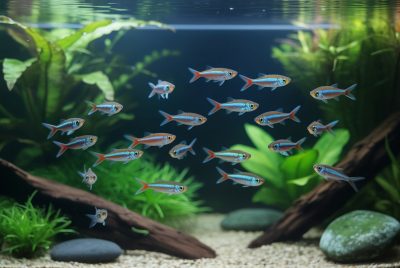Spider Wood Aquascape: Nature’s Art Underwater
*We may earn a commission for purchases made using our links. Please see our disclosure to learn more.
The first time I placed a piece of spider wood in my aquarium, I watched in amazement as it transformed the entire underwater landscape. Those twisted, branching tentacles seemed to breathe life into what was once just water and glass. Spider wood, harvested from Rhododendron and Azalea root systems, has become my favorite hardscaping material for creating captivating aquatic worlds that mimic nature’s artistry.
Key Takeaways
- Spider wood creates dramatic, naturalistic hardscapes with its unique branching structure
- Pre-soak your wood for 1-2 weeks before use to prevent floating and leaching of tannins
- Pair spider wood with carpeting plants, epiphytes, and mosses for stunning natural compositions
- Strategic placement can create depth perception and visual pathways in your aquarium
- Spider wood works well in various aquascaping styles, from Nature Aquarium to biotope recreations
- Proper maintenance includes occasional cleaning and monitoring for decomposition
“Aquascaping with spider wood is like painting with nature’s brushes. Each branch tells a story of organic growth and adaptation that we can harness to create underwater landscapes of remarkable beauty and complexity.”
— Mark Callahan, author of “The Planted Aquarium: A Comprehensive Guide to Aquascaping”
Recommended Products for Spider Wood Aquascaping
Based on my experience and research, here are four excellent spider wood aquascape products available on Amazon that would enhance your aquascaping journey:
WDEFUN Natural Spiderwood
Bring the beauty of nature to your aquarium with WDEFUN’s Natural Spiderwood. This 7-piece set of driftwood features unique, twisted shapes that add depth and charm to your aquatic landscape. Each piece is naturally sourced, manually selected, and perfect for aquariums, reptile tanks, or creative terrarium designs. Whether you're building a hideout for bettas and shrimp or just want to enhance your tank's visual appeal, these versatile wood pieces offer both function and aesthetic value.
- Natural Aesthetic: Each piece features unique shapes and textures that create a stunning, organic look in aquariums or terrariums.
- Multi-Use Decor: Suitable for fish tanks, reptile enclosures, and terrarium landscapes, making it highly versatile.
- Ready-to-Use: Pre-selected and sized between 4 to 8 inches, ideal for a wide range of aquarium sizes and layouts.
- May Float Initially: Some pieces may require soaking or weighting down before they sink naturally.
- Variations Expected: The actual driftwood shapes may differ from images shown, which might not suit all preferences.
- Smaller Size: Some users may find the pieces too small for larger tanks or bold aquascape designs.
Natural spider wood branches approximately 4–8 inches in length, ideal for small to medium aquariums or terrariums. Each piece features unique shapes and textures, offering a natural aesthetic. Thoroughly cleaned and ready for aquascaping, reptile climbing, or shrimp and betta hiding spots.
Fluval Mopani Driftwood
Add a natural touch to your aquatic setup with Fluval Mopani Driftwood. This all-natural piece features a beautiful, twisted root design that enhances the visual appeal of aquariums and terrariums alike. Each driftwood piece is sandblasted to remove debris, making it safe and ready for immediate use. Measuring approximately 4 to 10 inches, it's perfect for creating hiding spots for fish and adding rustic character to your tank.
- Natural Look: Enhances tank aesthetics with earthy tones and unique root shapes.
- Safe for Aquariums: Sandblasted to remove impurities for immediate, fish-safe use.
- Multi-Purpose: Ideal for both aquariums and terrariums, offering shelter and climbing spots.
- Inconsistent Size: Due to natural variations, size and shape may differ from images.
- Possible Tannins: May release tannins initially, slightly tinting aquarium water.
- Limited Availability: Medium and large sizes often out of stock, limiting options.
While not traditional spider wood, this complementary hardscape material pairs beautifully with spider wood. Its dense nature helps anchor lighter spider wood pieces in artistic arrangements.
Hamiledyi 6PCS Aquarium Driftwood
Bring a natural, rustic charm to your aquarium or terrarium with Hamiledyi’s 6-piece Spiderwood driftwood set. Each branch measures approximately 6 to 8 inches, carefully selected for its unique shape and organic texture. Lightweight yet sturdy, these driftwood pieces provide both aesthetic appeal and functional shelter for fish, shrimp, and reptiles. Perfect for aquascaping, reptile climbing, or moss attachment, they enhance both freshwater and dry environments. Boiling before use is recommended to remove tannins and ensure water clarity.
- Natural Material: Made from real driftwood, safe and long-lasting for aquatic or reptile habitats.
- Versatile Use: Great for aquariums, terrariums, moss trees, or even garden decor.
- Unique Shapes: Each piece has its own look, adding visual interest and realism.
- Pre-Soaking Needed: Requires boiling multiple times to fully remove tannins.
- Shape Variation: Natural branches vary in size and form, not identical to product photos.
- Smaller Pieces: May be too small for large tanks or as a centerpiece decoration.
Naturally harvested, these lightweight spider wood branches bring organic beauty and structure to your aquascape. Each piece features unique textures and shapes, perfect for crafting dynamic underwater scenes or adding interest to reptile habitats.
Majoywoo Natural Driftwood for Aquarium Decor
Enhance the beauty of your aquarium or terrarium with the Majoywoo Natural Spiderwood. This set includes three unique branches, each ranging from 7 to 11 inches in length. Each piece is carefully selected for its distinctive shape, adding organic charm and natural beauty to any aquatic or reptile environment. The driftwood can be used to create moss trees, provide shelter for aquatic life, or serve as climbing spots for reptiles. Its durable nature ensures it will last for years in both wet and dry conditions, offering both functionality and visual appeal.
- Unique Appearance: Each piece of spiderwood features its own distinctive shape, adding organic beauty to any setting.
- Versatile Use: Perfect for aquariums, terrariums, or as reptile decor, and suitable for various tank sizes and styles.
- Durable Quality: Sturdy and long-lasting, ideal for both underwater and arid environments.
- Size Variability: Due to the natural variation of driftwood, sizes and shapes may differ slightly from product photos.
- Pre-Soaking Required: May need to be boiled to remove tannins and ensure it sinks properly in water.
- Not for Large Tanks: The 7-11 inch size may not suit larger aquarium setups as a central decorative piece.
Ideal for aquascaping enthusiasts, this set features multiple pieces of unique spiderwood that can be arranged creatively in your tank or used across multiple setups. Perfect for adding natural beauty to small to medium aquariums or terrariums.
Understanding Spider Wood
Spider wood aquascape’s appeal lies in its organic, branching structure that resembles tree roots or branches reaching out in multiple directions. Harvested primarily from the root systems of Rhododendron or Azalea shrubs, this hardscape material has become increasingly popular in the aquascaping community for several compelling reasons.
When I first started working with spider wood aquascape, I appreciated its lightweight nature compared to other hardscape materials like dragon stone or lava rock. This makes it easier to manipulate and position, especially when trying to achieve those gravity-defying arrangements that seem to float in the water column.
The wood’s natural reddish-brown to tan color provides a beautiful contrast against green plants and can warm up the overall appearance of your aquascape. As it ages underwater, it develops a weathered patina that only enhances its natural beauty.
Unlike other aquarium woods such as Malaysian driftwood or mopani wood, spider wood aquascape has a more delicate, intricate structure that creates natural negative space, areas where water and light can pass through. This characteristic allows for more dynamic compositions where plants and fish can interact with and move through the hardscape in captivating ways.
The Ecological Significance
In natural ecosystems, submerged branches and roots create essential microhabitats for fish, invertebrates, and microorganisms. When we incorporate spider wood into our aquascapes, we’re actually recreating these vital ecological niches. The wood’s surface quickly colonizes with beneficial bacteria, contributing to the biological filtration of your tank while providing grazing areas for shrimp and other detrivores.
I’ve observed that many fish species, especially those from black water environments like bettas, tetras, and dwarf cichlids, display more natural behaviors when provided with the shelter and territorial boundaries that spider wood creates. This not only enhances the aesthetic appeal of your aquascape but also contributes significantly to the well-being of your aquatic inhabitants.
Preparing Spider Wood for Your Aquarium
I’ve learned (sometimes the hard way) that proper preparation is crucial when working with spider wood aquascape. Here’s my process:
First, I thoroughly rinse each piece under running water to remove dust and loose debris. Then comes the most important step: soaking. Spider wood aquascape is notoriously buoyant and will float unless properly waterlogged. I typically soak new pieces in a bucket or tub of water for 1-2 weeks, changing the water every few days.
During this soaking period, you’ll notice the water turning yellowish-brown. This is completely normal, spider wood aquascape releases tannins, organic compounds that color the water but are generally harmless to fish and plants. In fact, many blackwater biotope enthusiasts actually appreciate this effect, as it mimics the natural conditions found in many tropical streams and rivers.
For particularly stubborn pieces that refuse to sink, I’ve used several techniques with success. Boiling smaller pieces for 1-2 hours can speed up the waterlogging process significantly. For larger pieces, securing them temporarily to stone or slate using zip ties or aquarium-safe silicone until they waterlog naturally works well. Just be sure to hide these attachment points in your final design.
If the tannin leaching concerns you, I recommend adding activated carbon to your filter after setting up your aquascape, which will help remove the discoloration. Alternatively, using Seachem Purigen or similar products can effectively clear the water while preserving beneficial trace elements.
Designing with Spider Wood
When I approach a new spider wood aquascape, I like to think of the wood as the skeleton of my underwater landscape, it provides structure, flow, and focal points around which everything else is built.
Creating Depth and Perspective
One of the most powerful aspects of spider wood is its ability to create a sense of depth in the limited space of an aquarium. I often position larger, thicker branches toward the back of the tank, with finer branches reaching toward the front. This forced perspective technique makes the aquarium appear larger and more immersive than it actually is.
I’ve found that angling spider wood pieces so they converge toward a vanishing point (often slightly off-center) creates the most compelling compositions. This draws the viewer’s eye through the tank and creates a sense of journey and exploration.
In larger aquariums, I sometimes create triangular or V-shaped arrangements where multiple pieces of spider wood reach upward and outward from a central base point. This technique, inspired by the Dutch aquascaping style, creates dramatic visual impact while maintaining natural balance.
Working with Plants
Spider wood’s numerous branches and crevices make it an ideal host for various plants. In my designs, I frequently use:
- Epiphytes: Plants like Anubias, Bucephalandra, and Java fern can be attached directly to the wood using cotton thread or cyanoacrylate gel glue. Their roots will eventually grip the wood naturally.
- Mosses: Java moss, Christmas moss, and flame moss create a lush, aged appearance when tied or glued to spider wood. I often use moss to soften sharp transitions between wood and substrate.
- Carpeting Plants: Dwarf hairgrass, Monte Carlo, or Marsilea hirsuta planted around the base of spider wood create a meadow-like effect that enhances the natural appearance.
- Stem Plants: Strategically placed stem plants behind or between wood branches add color, texture, and additional depth to the composition.
For an especially striking effect, I sometimes create “islands” of aquatic growth centered around spider wood pieces. By concentrating plants around the base and along the branches while leaving open swimming spaces between these islands, I create a more naturalistic environment that mimics the patchy vegetation distribution found in nature.
I’ve discovered that allowing some branches to remain bare preserves the dramatic character of the wood while using plants to soften and naturalize other areas. This balance between exposed hardscape and lush vegetation creates the most visually compelling arrangements.
Spider Wood in Different Aquascaping Styles
What I love about spider wood is its versatility across various aquascaping styles:
- Nature Aquarium: In the tradition of Takashi Amano, spider wood creates excellent focal points and natural flow lines that guide viewers through lush planted compositions. In this style, I often combine spider wood with strategically placed stones to create a sense of harmony between different hardscape elements.
- Iwagumi with Accents: While traditional Iwagumi focuses on stone arrangements, adding a single, character-rich piece of spider wood can create a stunning accent that doesn’t overwhelm the minimalist aesthetic. I’ve found that smaller, more delicate pieces work best in this application.
- Jungle Style: Multiple spider wood pieces create the perfect foundation for dense, wild-looking arrangements featuring numerous plant species at different heights. For this style, I often stack or intertwine multiple pieces to create complex structures that mimic fallen trees in tropical forests.
- Blackwater Biotope: Spider wood is ideal for recreating the root systems seen in blackwater rivers of South America and Southeast Asia, especially when combined with leaf litter and minimal planting. The tannins released by the wood actually contribute to the authentic biotope conditions.
- Paludarium/Riparium: The branching nature of spider wood makes it perfect for breaking the water surface in setups that combine aquatic and emerged elements. I’ve created stunning paludariums where spider wood extends from underwater up to the emerged portion, creating natural platforms for semi-aquatic plants.
- Wabi-Kusa: In these miniature aquatic plantings, small pieces of spider wood provide perfect structure and mounting surfaces for mosses and small epiphytes, creating mesmerizing living sculptures.
Technical Considerations
Water Chemistry Impact
In my experience, spider wood has a mild but noticeable impact on water chemistry. Beyond the visible tannins it releases, spider wood can slightly lower pH levels in your aquarium. This makes it particularly suitable for species that prefer slightly acidic conditions, such as many tetras, bettas, and dwarf cichlids.
For those keeping species that prefer neutral or alkaline water, you might need to buffer your water accordingly or limit the amount of wood used. Regular water changes and the use of chemical filtration media can help maintain your desired parameters.
Compatibility with Aquatic Life
I’ve found spider wood to be universally well-received by aquatic inhabitants. Many fish species utilize the branches as natural territory markers and shelter. Shrimp colonies particularly thrive around spider wood, as they can graze on the biofilm that develops on the surface and hide among the intricate branches.
One special consideration is for fish with delicate fins, such as bettas or fancy goldfish. While spider wood doesn’t typically have the sharp edges that some rocks might have, I still recommend inspecting each piece carefully and sanding down any potentially problematic areas before introduction.
Maintenance and Long-term Care
In my years of working with spider wood, I’ve developed some maintenance practices that help preserve its beauty and structural integrity:
Spider wood is organic material, so it will eventually break down underwater. While this process takes years, I regularly inspect my wood for signs of excessive softening or deterioration. Gentle cleaning with a soft brush during water changes helps remove accumulated algae or detritus without damaging attached plants.
If you notice fungal growth (often appearing as white fuzz) on new spider wood, don’t panic! This is normal during the initial submersion period and is generally harmless. The growth typically disappears after a few weeks as the wood acclimates to underwater conditions. Some fish, like Otocinclus catfish, will actually eat this biofilm.
For long-term preservation, maintaining stable water parameters and good water flow around the wood helps prevent problematic algae growth. I’ve found that targeted circulation around complex spider wood arrangements ensures that detritus doesn’t accumulate in hard-to-reach areas.
Seasonal Refreshment
To keep my spider wood aquascapes looking their best, I perform what I call “seasonal refreshments” every 4-6 months. This involves gently removing and replanting any overgrown areas, trimming moss, and carefully cleaning the exposed wood surfaces with a soft toothbrush during water changes.
These periodic interventions prevent the wood from becoming completely obscured by plant growth while maintaining the intentional balance between hardscape and vegetation that makes spider wood aquascapes so captivating.
Advanced Techniques
Creating Underwater Trees
One of my favorite advanced applications of spider wood is creating underwater “trees.” By positioning a substantial piece vertically and attaching moss or small-leaved plants like Anubias nana ‘Petite’ to the branches, you can create the illusion of a submerged tree. This dramatic focal point becomes even more impressive when fish swim through and around the branches.
Multi-wood Combinations
While spider wood alone creates stunning aquascapes, I’ve achieved some of my most impressive designs by combining it with other wood types. Manzanita branches paired with spider wood create varied textures and branch patterns. Larger pieces of Malaysian driftwood or mopani wood can provide a substantial base from which spider wood branches can emerge, creating more complex arrangements.
Vertical Space Utilization
In deeper tanks, I’ve had success creating multi-level environments using spider wood. By positioning pieces to create distinct zones at different heights, you can encourage fish to utilize the entire water column rather than staying at one level. This not only looks more natural but also promotes healthy activity among your aquatic inhabitants.
Conclusion
Spider wood aquascaping represents the perfect marriage of artistic expression and natural science. Through thoughtful arrangement of these intricate wooden structures and complementary planting, we can create underwater landscapes that captivate the imagination while providing healthy environments for aquatic life.
What I find most rewarding about spider wood aquascapes is their ever-evolving nature. As plants grow, as biofilm develops, as the wood itself matures underwater, the aquascape transforms, becoming more integrated and natural with time. This living art form continues to inspire me after years of aquascaping, and I hope it will inspire you to explore the creative possibilities that spider wood offers.
Whether you’re creating your first planted tank or are a seasoned aquascaper looking for new inspiration, spider wood provides a versatile, naturalistic foundation for underwater landscapes that mimic the breathtaking beauty of nature’s aquatic environments.
Frequently Asked Questions
How long does spider wood last in an aquarium?
Spider wood typically lasts 2-5 years underwater before significant decomposition occurs. The lifespan depends on water parameters, biological activity in your tank, and the initial density of the wood. Higher temperatures and more acidic conditions generally accelerate decomposition.
Can I use spider wood in a tank with high pH?
Yes, spider wood can be used in high pH tanks, though it will gradually release tannins that might slightly lower pH. If maintaining a high pH is critical for your livestock, you may need to use less wood or incorporate materials like limestone to buffer the water.
How do I attach plants to spider wood?
The most effective methods are using cotton or fishing line to tie plants temporarily, aquarium-safe cyanoacrylate gel (super glue), or stainless steel pins for mosses. Most epiphytes will eventually attach their roots to the wood, at which point the ties can be removed.
Will spider wood hurt my fish or shrimp?
Spider wood is safe for all aquatic life. In fact, it creates beneficial microhabitats and grazing surfaces for many species. Just ensure any sharp points are smoothed before adding the wood to your aquarium, especially if you keep fish with delicate fins.
How do I prevent spider wood from floating?
Thoroughly soak your spider wood for 1-2 weeks before use. For stubborn pieces, boiling smaller sections or attaching them to slate or stone using aquarium-safe zip ties or silicone can help keep them submerged until they naturally waterlog.
















